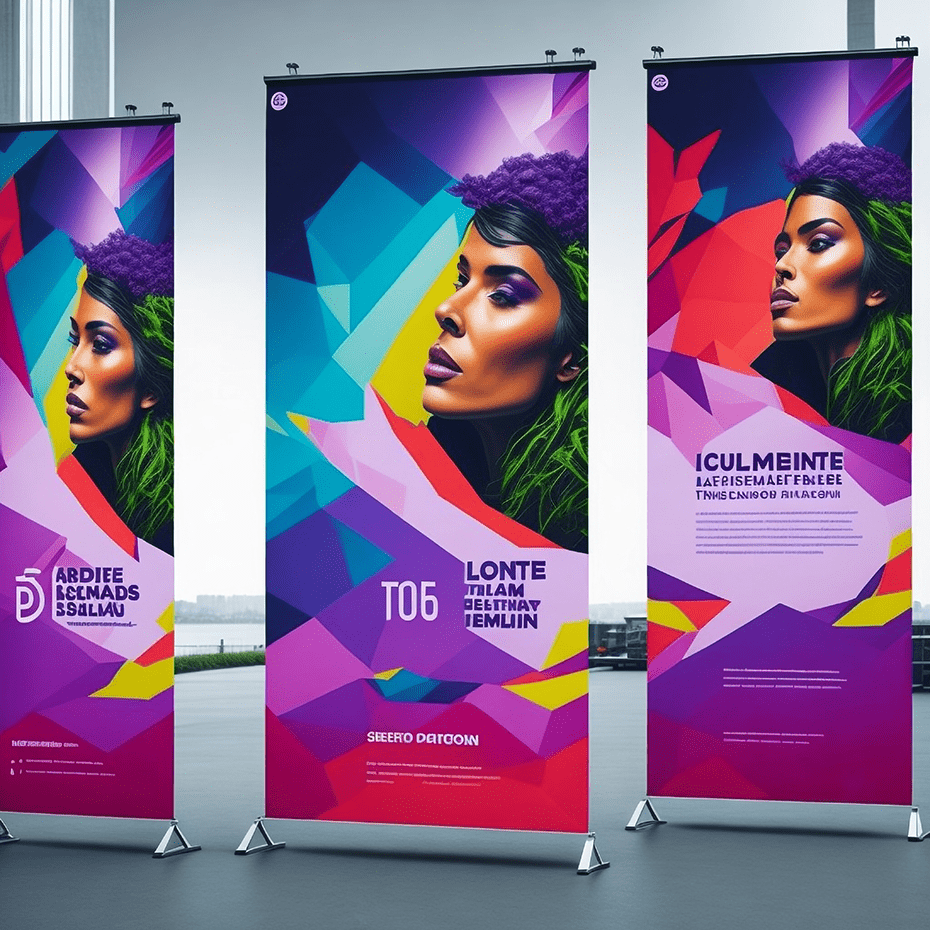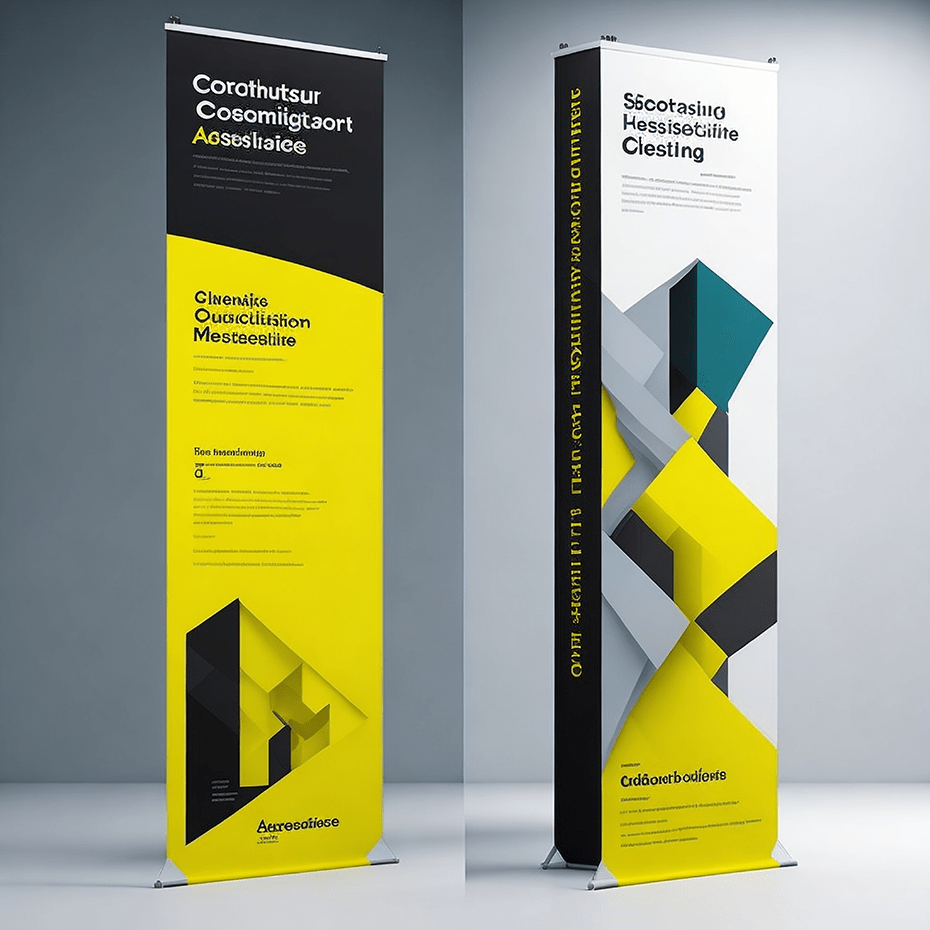Introduction
Trade shows are highly competitive environments where businesses have the opportunity to showcase their products and services to a targeted audience. However, with numerous competitors vying for attention, it’s crucial to make a lasting impression that drives conversions. Engaging trade show banners play a pivotal role in capturing visitors’ attention and turning them into potential customers. In this blog post, we will explore the essential steps to create trade show banners that not only maximize ROI but also deliver significant business results.
Understanding Your Target Audience
To create effective trade show banners, you must first understand your target audience. Comprehensive market research is essential to identify the demographics, preferences, and pain points of potential customers who attend the trade show. By gaining insights into your audience, you can tailor your banner content to resonate with their needs and interests, making it more likely to capture their attention and engage them with your brand.
Example: Let’s consider a company that manufactures eco-friendly, reusable water bottles. Through market research, they identify their primary target audience as environmentally-conscious millennials who are passionate about reducing single-use plastic waste. Armed with this knowledge, they can create trade show banners that highlight the eco-friendly aspects of their product and its positive impact on the environment, appealing directly to their audience’s values.
Setting Clear Objectives
To measure the success of your trade show banners, it is crucial to set clear and measurable objectives. Align these goals with your overall marketing and sales strategy to ensure that your banners contribute to the conversion funnel effectively. Whether your objective is to generate leads, increase brand awareness, or boost sales, having well-defined goals will guide your banner design and content decisions.

Example: Let’s take the example of a software company attending a tech trade show to launch a new productivity app. Their objectives may include generating at least 500 leads during the event and securing partnerships with at least three potential investors. By defining these specific goals, they can design their banners with focused messaging and call-to-action (CTA) that align with these objectives, maximizing their chances of achieving them.
Crafting Captivating Visuals
Visual appeal is essential in attracting visitors to your trade show booth. High-quality images and graphics that represent your brand and communicate your message effectively can make a significant impact. Utilize vibrant colors, eye-catching fonts, and a well-balanced layout to create visually stunning banners that stand out in the bustling trade show environment.

Example: Imagine a fashion brand showcasing its latest collection at a fashion expo. They create visually stunning banners featuring high-resolution images of their trendy clothing line modeled by influencers. The banners use bold colors and sleek typography to reflect the brand’s modern and stylish identity, instantly capturing the attention of fashion-forward attendees.
Writing Compelling Copy
While captivating visuals grab attention, persuasive copy is what drives conversions. Craft a concise and compelling headline that conveys the unique value proposition of your product or service. Use persuasive language that appeals to the emotions and pain points of your target audience. Additionally, incorporate a strong call-to-action (CTA) that encourages visitors to take the desired action, such as visiting your booth or signing up for a demo.
Example: A wellness company promoting a new fitness program at a health and wellness expo can use compelling copy on their banners. They might use phrases like “Transform Your Body and Mind,” “Join the Journey to a Healthier You,” and “Limited-Time Offer: Sign Up Today for Exclusive Benefits.” This persuasive language appeals to attendees’ desire for improved well-being and encourages them to take immediate action.
Prioritizing Clarity and Simplicity
In the fast-paced trade show environment, simplicity is key. Avoid overwhelming visitors with excessive information on your banners. Instead, focus on delivering a clear and concise message that communicates the most important aspects of your offering. A clutter-free design ensures that your audience can quickly grasp your key selling points without feeling overwhelmed.

Example: Consider a technology startup showcasing a groundbreaking AI-powered gadget at a tech conference. To ensure clarity, they focus their banner messaging on the gadget’s key features and how it simplifies everyday tasks. The banner uses concise bullet points and minimal text to convey the gadget’s benefits quickly, making it easy for busy attendees to grasp its value proposition at a glance.
Branding Consistency
Your trade show banners are an extension of your brand identity. Maintaining consistency is vital for brand recall and recognition. Incorporate your brand’s logo, slogans, and colors throughout the banner design to reinforce your brand’s identity and make it easier for attendees to identify your booth amidst the sea of competitors.
Example: A popular soft drink company exhibiting at a food and beverage trade show ensures that its banners prominently feature its iconic logo, signature colors, and catchy tagline. This consistency reinforces their brand identity and makes it easier for attendees to identify their booth amidst the sea of competitors.
Interactive Elements and Technology Integration
Embrace technology to enhance engagement with your trade show banners. Include QR codes and NFC tags on your banners, allowing visitors to scan and access additional information or special offers. Consider using augmented reality (AR) or virtual reality (VR) experiences to immerse visitors in your brand story and product demonstrations. By integrating technology into your banners, you create memorable experiences that leave a lasting impression on attendees.
Example: An electronics company showcasing its latest smartphones at a consumer electronics expo can incorporate QR codes on its banners. This allows visitors to scan and explore interactive product demos and exclusive offers on their website. This interactive element not only engages attendees but also facilitates lead capture and conversion.
A/B Testing and Iterative Improvements
To optimize the effectiveness of your trade show banners, conduct A/B testing with different banner variations. Test different visuals, copy, and CTAs to determine what resonates best with your audience. Gather feedback from your team and trade show attendees, and use data-driven insights to make iterative improvements to your banner designs. Continuously refining your banners based on real-world results ensures that you’re always improving your ROI.
Example: A home improvement company attending a home and garden show can create two banner designs—one focusing on kitchen renovations and the other on bathroom remodels. By comparing the performance of each banner, they can identify which offering resonates better with attendees and tailor their future banners accordingly.
Investing in Quality Materials
In the rush to prepare for trade shows, some businesses overlook the importance of investing in high-quality banner materials. Opt for durable materials that can withstand frequent use and transportation. A well-constructed banner not only enhances your brand’s professionalism but also saves you money in the long run, as it won’t need constant replacements.
Example: A travel agency promoting exotic destinations at a travel expo invests in durable, weather-resistant banners that can be reused for multiple events. This not only saves on replacement costs but also ensures their banners look fresh and vibrant throughout the expo, leaving a positive impression on attendees.
Preparing for Trade Show Success
Strategically position your trade show banners within your booth to maximize visibility and attract foot traffic. Coordinate your banner messaging with other marketing collateral, such as brochures and promotional materials, to create a cohesive brand experience for visitors. Train your booth staff to engage with attendees effectively, ensuring they can answer questions and lead potential customers toward conversion.
Example: An innovative tech startup places its banner near the entrance of its booth, making it the first thing attendees see as they enter. This strategic placement ensures that even those passing by quickly can catch a glimpse of their brand and offerings, increasing the chances of drawing them in for further engagement.
Measuring ROI and Analyzing Results
Once the trade show is over, it’s time to assess the impact of your banners on your ROI. Track leads generated through the trade show banners and calculate the actual return on investment. Compare the results with the objectives set in the beginning to gauge the success of your efforts. Analyze the data and feedback collected during the event to identify areas for improvement and make informed decisions for future trade shows.
Example: A software company measures the number of attendees who scanned their QR code and downloaded their app during the expo. They can then calculate the cost per lead generated from the trade show to evaluate the effectiveness of their banners in driving conversions. They also collect feedback from booth visitors to identify what aspects of the banners resonated the most and what improvements can be made for future events.
Conclusion
Creating engaging trade show banners that convert is a powerful marketing tool for any business. By understanding your audience, setting clear objectives, and crafting visually stunning banners with compelling copy, you can captivate trade show attendees and drive meaningful results. Prioritizing clarity, and consistency, and incorporating interactive elements will further enhance engagement and leave a lasting impression on potential customers. Remember, the key to maximizing ROI lies in continuous improvement, so use data-driven insights to refine your banner designs and ensure each trade show yields greater success than the last. Embrace the potential of well-designed trade show banners, and unlock new opportunities for business growth.
Looking to put these trade show banner tips to the test? Don’t miss the opportunity to showcase your brand and connect with potential customers at upcoming trade show events. Be sure to plan ahead, create engaging trade show banners, and implement the strategies discussed in this article to maximize your ROI and make a lasting impact on attendees. See you there!

